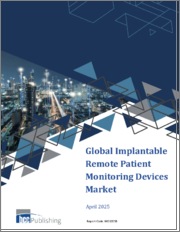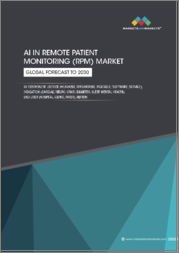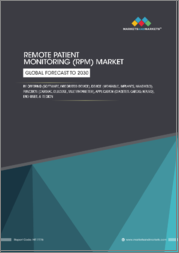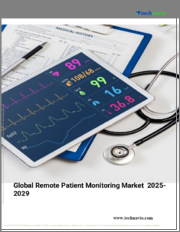
|
시장보고서
상품코드
1620835
원격 환자 모니터링 시장 : 제품, 적응증, 최종 사용자별 - 세계 예측(2025-2030년)Remote Patient Monitoring Market by Product (Devices, Services, Software), Indication (Blood Pressure, Chronic Obstructive Pulmonary Disease, Congestive Heart Failure), End-User - Global Forecast 2025-2030 |
||||||
원격 환자 모니터링 시장은 2023년에 309억 7,000만 달러로 평가되었습니다. 2024년에는 363억 1,000만 달러에 도달할 것으로 예측되며, CAGR 17.65%로 성장하여 2030년에는 966억 7,000만 달러에 달할 것으로 예상됩니다.
원격 환자 모니터링(RPM)은 의료 서비스 제공업체가 웨어러블 센서 및 모바일 건강 앱과 같은 커넥티드 디바이스를 사용하여 환자의 건강 데이터와 상태를 원격으로 추적할 수 있는 기술 및 프로세스를 말합니다. 만성질환 증가, 고령화, 개인 맞춤형 의료에 대한 수요 증가로 인해 이 기술은 매우 중요하며, RPM은 만성질환 관리, 급성기 이후 치료, 예방 치료 등 다양한 분야에 적용되어 조기 개입을 가능하게 하고 의료 비용을 절감할 수 있습니다. 주요 최종 사용자로는 병원, 전문 클리닉, 재택치료 현장 등이 있으며, 전통적인 의료 모델에서 환자 중심의 접근 방식으로의 전환을 촉진하고 있습니다.
| 주요 시장 통계 | |
|---|---|
| 기준년(2023) | 309억 7,000만 달러 |
| 추정년(2024) | 363억 1,000만 달러 |
| 예측년(2030) | 966억 7,000만 달러 |
| CAGR(%) | 17.65% |
시장 성장의 원동력은 IoT 및 AI 기술의 발전, 원격 의료 솔루션의 확대, 디지털 건강 혁신에 대한 인센티브를 제공하는 정부 지원 정책 등 다양한 요인이 있으며, 코로나19 팬데믹은 RPM의 필요성을 더욱 강조하고 병원 재입원을 줄이면서 의료 서비스 제공과 환자 참여를 강화할 수 있는 잠재력을 강조했습니다. 의료 서비스 제공과 환자 참여를 강화할 수 있는 가능성을 강조했습니다. 그러나 규제적 장애물, 데이터 보안 문제, 기존 의료 인프라와의 통합 문제 등의 과제는 여전히 남아있습니다. 또한, 일부 지역에서는 고속 인터넷에 대한 접근성이 제한되어 있어 RPM 서비스 보급에 걸림돌이 되고 있습니다.
새로운 기회를 포착하기 위해 기업은 전자 의료 기록과 원활하게 통합되는 상호 운용 가능하고 안전한 RPM 시스템 개발에 집중해야 하며, AI 기반 예측 분석에 대한 연구 개발에 투자하면 RPM의 역량을 더욱 향상시킬 수 있습니다. 사용자 친화적이고 신뢰할 수 있는 기기를 개발하기 위해서는 의료 서비스 제공업체 및 하이테크 기업과의 협력이 필수적입니다. 혁신가들은 특히 의료 접근성이 제한적인 중저소득 국가 등 미개척 시장을 개척해야 합니다.
RPM은 유망한 성장세에도 불구하고 기술적, 물류적 장벽으로 인해 성장에 제약을 받고 있습니다. 정책 제안과 전략적 파트너십을 통해 이러한 문제를 해결함으로써 시장 확대를 촉진할 수 있으며, RPM의 잠재력을 최대한 활용하고 진화하는 디지털 헬스 환경에서 더 나은 의료 결과와 환자 만족도를 보장하기 위해서는 모바일 헬스 테크놀로지의 혁신을 촉진하고 사용자 교육을 강화하는 것이 필수적입니다. 혁신을 촉진하고 사용자 교육을 강화하는 것이 필수적입니다.
시장 역학: 빠르게 진화하는 원격 환자 모니터링 시장의 주요 시장 인사이트 공개
원격 환자 모니터링 시장은 수요 및 공급의 역동적인 상호작용에 의해 변화하고 있습니다. 이러한 시장 역학의 변화를 이해함으로써 기업은 정보에 입각한 투자 결정을 내리고, 전략적 의사결정을 정교화하며, 새로운 비즈니스 기회를 포착할 수 있습니다. 이러한 트렌드를 종합적으로 파악함으로써 기업은 정치적, 지리적, 기술적, 사회적, 경제적 영역 전반에 걸친 다양한 리스크를 줄일 수 있으며, 소비자 행동과 그것이 제조 비용 및 구매 동향에 미치는 영향을 보다 명확하게 이해할 수 있습니다.
- 시장 성장 촉진요인
- 만성질환 증가와 고령화
- 원격 의료 솔루션에 대한 인식과 수용도 증가
- 각국의 헬스케어 인프라의 발전과 개선
- 시장 성장 억제요인
- 원격 모니터링 절차 및 솔루션과 관련된 높은 비용
- 시장 기회
- 새로운 원격 환자 모니터링 기술을 개발하기 위한 활발한 활동
- 원격 모니터링 솔루션에 대한 인공지능의 높은 잠재력
- 시장 과제
- 원격 모니터링 시스템의 데이터 보안 및 개인 정보 보호에 대한 우려
Porter's Five Forces: 원격 환자 모니터링 시장 탐색을 위한 전략 도구
Porter's Five Forces 프레임워크는 시장 상황경쟁 구도를 이해하는 중요한 도구입니다. Porter의 Five Forces 프레임워크는 기업의 경쟁력을 평가하고 전략적 기회를 탐색할 수 있는 명확한 방법을 제공합니다. 이 프레임워크는 기업이 시장 내 세력도를 평가하고 신규 사업의 수익성을 판단하는 데 도움이 됩니다. 이러한 통찰력을 통해 기업은 강점을 활용하고, 약점을 해결하고, 잠재적인 도전을 피하고, 보다 강력한 시장 포지셔닝을 확보할 수 있습니다.
PESTLE 분석 : 원격 환자 모니터링 시장의 외부 영향 파악
외부 거시 환경 요인은 원격 환자 모니터링 시장의 성과 역학을 형성하는 데 매우 중요한 역할을 합니다. 정치적, 경제적, 사회적, 기술적, 법적, 환경적 요인에 대한 분석은 이러한 영향을 탐색하는 데 필요한 정보를 제공하며, PESTLE 요인을 조사함으로써 기업은 잠재적 위험과 기회를 더 잘 이해할 수 있습니다. 이러한 분석을 통해 기업은 규제, 소비자 선호도, 경제 동향의 변화를 예측하고 선제적이고 능동적인 의사결정을 내릴 준비를 할 수 있습니다.
시장 점유율 분석 원격 환자 모니터링 시장에서경쟁 구도 파악
원격 환자 모니터링 시장의 상세한 시장 점유율 분석을 통해 공급업체의 성과를 종합적으로 평가할 수 있습니다. 기업은 수익, 고객 기반, 성장률과 같은 주요 지표를 비교하여 경쟁적 위치를 파악할 수 있습니다. 이 분석은 시장의 집중화, 단편화 및 통합 추세를 파악할 수 있으며, 공급업체는 치열한 경쟁 속에서 자신의 입지를 강화할 수 있는 전략적 의사결정을 내리는 데 필요한 통찰력을 얻을 수 있습니다.
FPNV 포지셔닝 매트릭스 원격 환자 모니터링 시장에서의 벤더 성능 평가
FPNV 포지셔닝 매트릭스는 원격 환자 모니터링 시장에서 공급업체를 평가하는 중요한 도구입니다. 이 매트릭스를 통해 비즈니스 조직은 벤더의 비즈니스 전략과 제품 만족도를 기반으로 평가하여 목표에 부합하는 정보에 입각한 의사결정을 내릴 수 있으며, 4개의 사분면으로 벤더를 명확하고 정확하게 세분화하여 전략 목표에 가장 적합한 파트너와 솔루션을 식별할 수 있습니다. 전략 목표에 가장 적합한 파트너와 솔루션을 식별할 수 있습니다.
원격 환자 모니터링 시장에서 성공하기 위한 전략 분석 및 권장 사항
원격 환자 모니터링 시장 전략 분석은 세계 시장에서 입지를 강화하고자 하는 기업에게 필수적입니다. 주요 자원, 역량 및 성과 지표를 검토함으로써 기업은 성장 기회를 식별하고 개선할 수 있습니다. 이러한 접근 방식을 통해 경쟁 환경의 과제를 극복하고 새로운 비즈니스 기회를 활용하여 장기적인 성공을 거둘 수 있는 체계를 구축할 수 있습니다.
이 보고서는 주요 관심 분야를 포괄하는 시장에 대한 종합적인 분석을 제공합니다.
1. 시장 침투도 : 현재 시장 환경의 상세한 검토, 주요 기업의 광범위한 데이터, 시장 도달 범위 및 전반적인 영향력 평가.
2. 시장 개척도: 신흥 시장에서의 성장 기회를 파악하고, 기존 분야의 확장 가능성을 평가하며, 미래 성장을 위한 전략적 로드맵을 제공합니다.
3. 시장 다각화 : 최근 제품 출시, 미개척 지역, 업계의 주요 발전, 시장을 형성하는 전략적 투자를 분석합니다.
4. 경쟁 평가 및 정보 : 경쟁 구도를 철저히 분석하여 시장 점유율, 사업 전략, 제품 포트폴리오, 인증, 규제 당국의 승인, 특허 동향, 주요 기업의 기술 발전 등을 검토합니다.
5. 제품 개발 및 혁신 : 미래 시장 성장을 가속할 것으로 예상되는 첨단 기술, 연구 개발 활동 및 제품 혁신을 강조합니다.
이해관계자들이 충분한 정보를 바탕으로 의사결정을 내릴 수 있도록 다음과 같은 중요한 질문에 대한 답변도 제공합니다.
1. 현재 시장 규모와 향후 성장 전망은?
2. 최고의 투자 기회를 제공하는 제품, 부문, 지역은?
3. 시장을 형성하는 주요 기술 동향과 규제의 영향은?
4. 주요 벤더 시장 점유율과 경쟁 포지션은?
5.벤더 시장 진입 및 철수 전략의 원동력이 되는 수익원과 전략적 기회는 무엇인가?
목차
제1장 서문
제2장 조사 방법
제3장 주요 요약
제4장 시장 개요
제5장 시장 인사이트
- 시장 역학
- 성장 촉진요인
- 성장 억제요인
- 기회
- 과제
- 시장 세분화 분석
- Porter's Five Forces 분석
- PESTEL 분석
- 정치적
- 경제적
- 사회적
- 기술적
- 법적
- 환경적
제6장 원격 환자 모니터링 시장 : 제품별
- 디바이스
- 특수 모니터
- 바이탈 사인 모니터
- 서비스
- 소프트웨어
제7장 원격 환자 모니터링 시장 적응증별
- 혈압
- 만성 폐색성 폐질환
- 울혈성 심부전
- 당뇨병
- 정신 건강
- 신생아
- 신경학
- 온도
제8장 원격 환자 모니터링 시장 : 최종 사용자별
- 환자
- 지불자
- 공급자
- 외래 진료 센터
- 재택 케어 시설 및 장기 케어 센터
- 병원 및 클리닉
제9장 아메리카의 원격 환자 모니터링 시장
- 아르헨티나
- 브라질
- 캐나다
- 멕시코
- 미국
제10장 아시아태평양의 원격 환자 모니터링 시장
- 호주
- 중국
- 인도
- 인도네시아
- 일본
- 말레이시아
- 필리핀
- 싱가포르
- 한국
- 대만
- 태국
- 베트남
제11장 유럽·중동 및 아프리카의 원격 환자 모니터링 시장
- 덴마크
- 이집트
- 핀란드
- 프랑스
- 독일
- 이스라엘
- 이탈리아
- 네덜란드
- 나이지리아
- 노르웨이
- 폴란드
- 카타르
- 러시아
- 사우디아라비아
- 남아프리카공화국
- 스페인
- 스웨덴
- 스위스
- 터키
- 아랍에미리트(UAE)
- 영국
제12장 경쟁 구도
- 시장 점유율 분석, 2023
- FPNV 포지셔닝 매트릭스, 2023
- 경쟁 시나리오 분석
- 전략 분석과 제안
기업 목록
- Abbott Laboratories
- Aerotel Medical Systems Ltd
- Allscripts Healthcare Solutions Inc.
- Amazon Web Services, Inc.
- AMD Global Telemedicine, Inc.
- Biotronik SE & Co. KG
- Boston Scientific Corp.
- CareValidate Inc.
- Cisco Systems, Inc.
- Click Labs Inc.
- Comarch SA
- DexCom, Inc.
- Drager Medical GmbH
- F. Hoffmann-La Roche AG
- GE Healthcare Technologies Inc.
- Glooko, Inc.
- Google LLC by Alphabet Inc.
- Honeywell International Inc.
- International Business Machines Corporation
- InTouch Technologies, Inc.
- Johnson & Johnson Services, Inc.
- Koninklijke Philips NV
- LifeWatch by BioTelemetry Inc.
- Masimo Corporation
- McKesson Corporation
- Medtronic Plc
- Microsoft Corporation
- Omron Corp.
- Oracle Corporation
- Pexip Holding ASA
- Siemens Healthiners AG
- Teladoc Health, Inc.
- Tunstall Healthcare Group Ltd.
The Remote Patient Monitoring Market was valued at USD 30.97 billion in 2023, expected to reach USD 36.31 billion in 2024, and is projected to grow at a CAGR of 17.65%, to USD 96.67 billion by 2030.
Remote Patient Monitoring (RPM) refers to technology and processes that enable healthcare providers to track patients' health data and conditions remotely, using connected devices like wearable sensors and mobile health apps. This technology is crucial due to the increasing prevalence of chronic diseases, an aging population, and the growing demand for personalized healthcare. RPM is applied across various domains such as chronic disease management, post-acute care, and preventive care, enabling early intervention and reducing healthcare costs. Key end-users include hospitals, specialty clinics, and home healthcare settings, fostering a shift from traditional healthcare models to more patient-centered approaches.
KEY MARKET STATISTICS Base Year [2023] USD 30.97 billion Estimated Year [2024] USD 36.31 billion Forecast Year [2030] USD 96.67 billion CAGR (%) 17.65% Market growth is driven by factors such as advancements in IoT and AI technologies, the escalation of telehealth solutions, and supportive government policies incentivizing digital health innovations. The COVID-19 pandemic further emphasized the need for RPM, highlighting its potential to enhance healthcare delivery and patient engagement while reducing hospital readmissions. However, challenges persist, including regulatory hurdles, data security concerns, and integration issues with existing healthcare infrastructure. Additionally, limited access to high-speed internet in certain regions hampers the widespread adoption of RPM services.
To seize emerging opportunities, businesses should focus on developing interoperable and secure RPM systems that seamlessly integrate with electronic health records. Investment in research and development of AI-driven predictive analytics can further enhance RPM capabilities. Collaboration with healthcare providers and tech companies to create user-friendly and reliable devices will be critical. Innovators should also explore untapped markets, particularly in low and middle-income countries where healthcare access is limited.
Despite its promising trajectory, RPM's growth is constrained by technological and logistical barriers. Addressing these challenges through policy advocacy and strategic partnerships can facilitate market expansion. Fostering innovation in mobile health technologies and enhancing user education are vital for leveraging RPM's full potential, ensuring better healthcare outcomes and patient satisfaction in the evolving digital health landscape.
Market Dynamics: Unveiling Key Market Insights in the Rapidly Evolving Remote Patient Monitoring Market
The Remote Patient Monitoring Market is undergoing transformative changes driven by a dynamic interplay of supply and demand factors. Understanding these evolving market dynamics prepares business organizations to make informed investment decisions, refine strategic decisions, and seize new opportunities. By gaining a comprehensive view of these trends, business organizations can mitigate various risks across political, geographic, technical, social, and economic domains while also gaining a clearer understanding of consumer behavior and its impact on manufacturing costs and purchasing trends.
- Market Drivers
- Increasing prevalence of chronic diseases and aging population
- Growing awareness and acceptance of telehealth solutions
- Evolving and improving healthcare infrastructures across economies
- Market Restraints
- High costs associated with telemonitoring procedures and solutions
- Market Opportunities
- Robust activities to develop new remote patient monitoring technology
- Higher potential of artificial intelligence in telemonitoring solutions
- Market Challenges
- Data security and privacy concerns of telemonitoring systems
Porter's Five Forces: A Strategic Tool for Navigating the Remote Patient Monitoring Market
Porter's five forces framework is a critical tool for understanding the competitive landscape of the Remote Patient Monitoring Market. It offers business organizations with a clear methodology for evaluating their competitive positioning and exploring strategic opportunities. This framework helps businesses assess the power dynamics within the market and determine the profitability of new ventures. With these insights, business organizations can leverage their strengths, address weaknesses, and avoid potential challenges, ensuring a more resilient market positioning.
PESTLE Analysis: Navigating External Influences in the Remote Patient Monitoring Market
External macro-environmental factors play a pivotal role in shaping the performance dynamics of the Remote Patient Monitoring Market. Political, Economic, Social, Technological, Legal, and Environmental factors analysis provides the necessary information to navigate these influences. By examining PESTLE factors, businesses can better understand potential risks and opportunities. This analysis enables business organizations to anticipate changes in regulations, consumer preferences, and economic trends, ensuring they are prepared to make proactive, forward-thinking decisions.
Market Share Analysis: Understanding the Competitive Landscape in the Remote Patient Monitoring Market
A detailed market share analysis in the Remote Patient Monitoring Market provides a comprehensive assessment of vendors' performance. Companies can identify their competitive positioning by comparing key metrics, including revenue, customer base, and growth rates. This analysis highlights market concentration, fragmentation, and trends in consolidation, offering vendors the insights required to make strategic decisions that enhance their position in an increasingly competitive landscape.
FPNV Positioning Matrix: Evaluating Vendors' Performance in the Remote Patient Monitoring Market
The Forefront, Pathfinder, Niche, Vital (FPNV) Positioning Matrix is a critical tool for evaluating vendors within the Remote Patient Monitoring Market. This matrix enables business organizations to make well-informed decisions that align with their goals by assessing vendors based on their business strategy and product satisfaction. The four quadrants provide a clear and precise segmentation of vendors, helping users identify the right partners and solutions that best fit their strategic objectives.
Strategy Analysis & Recommendation: Charting a Path to Success in the Remote Patient Monitoring Market
A strategic analysis of the Remote Patient Monitoring Market is essential for businesses looking to strengthen their global market presence. By reviewing key resources, capabilities, and performance indicators, business organizations can identify growth opportunities and work toward improvement. This approach helps businesses navigate challenges in the competitive landscape and ensures they are well-positioned to capitalize on newer opportunities and drive long-term success.
Key Company Profiles
The report delves into recent significant developments in the Remote Patient Monitoring Market, highlighting leading vendors and their innovative profiles. These include Abbott Laboratories, Aerotel Medical Systems Ltd, Allscripts Healthcare Solutions Inc., Amazon Web Services, Inc., AMD Global Telemedicine, Inc., Biotronik SE & Co. KG, Boston Scientific Corp., CareValidate Inc., Cisco Systems, Inc., Click Labs Inc., Comarch SA, DexCom, Inc., Drager Medical GmbH, F. Hoffmann-La Roche AG, GE Healthcare Technologies Inc., Glooko, Inc., Google LLC by Alphabet Inc., Honeywell International Inc., International Business Machines Corporation, InTouch Technologies, Inc., Johnson & Johnson Services, Inc., Koninklijke Philips N.V., LifeWatch by BioTelemetry Inc., Masimo Corporation, McKesson Corporation, Medtronic Plc, Microsoft Corporation, Omron Corp., Oracle Corporation, Pexip Holding ASA, Siemens Healthiners AG, Teladoc Health, Inc., and Tunstall Healthcare Group Ltd..
Market Segmentation & Coverage
This research report categorizes the Remote Patient Monitoring Market to forecast the revenues and analyze trends in each of the following sub-markets:
- Based on Product, market is studied across Devices, Services, and Software. The Devices is further studied across Specialized Monitors and Vital Sign Monitors.
- Based on Indication, market is studied across Blood Pressure, Chronic Obstructive Pulmonary Disease, Congestive Heart Failure, Diabetes, Mental Health, Neonatal, Neurology, and Temperature.
- Based on End-User, market is studied across Patients, Payers, and Providers. The Providers is further studied across Ambulatory Care Centers, Home Care Settings & Long Term Care Centers, and Hospitals & Clinics.
- Based on Region, market is studied across Americas, Asia-Pacific, and Europe, Middle East & Africa. The Americas is further studied across Argentina, Brazil, Canada, Mexico, and United States. The United States is further studied across California, Florida, Illinois, New York, Ohio, Pennsylvania, and Texas. The Asia-Pacific is further studied across Australia, China, India, Indonesia, Japan, Malaysia, Philippines, Singapore, South Korea, Taiwan, Thailand, and Vietnam. The Europe, Middle East & Africa is further studied across Denmark, Egypt, Finland, France, Germany, Israel, Italy, Netherlands, Nigeria, Norway, Poland, Qatar, Russia, Saudi Arabia, South Africa, Spain, Sweden, Switzerland, Turkey, United Arab Emirates, and United Kingdom.
The report offers a comprehensive analysis of the market, covering key focus areas:
1. Market Penetration: A detailed review of the current market environment, including extensive data from top industry players, evaluating their market reach and overall influence.
2. Market Development: Identifies growth opportunities in emerging markets and assesses expansion potential in established sectors, providing a strategic roadmap for future growth.
3. Market Diversification: Analyzes recent product launches, untapped geographic regions, major industry advancements, and strategic investments reshaping the market.
4. Competitive Assessment & Intelligence: Provides a thorough analysis of the competitive landscape, examining market share, business strategies, product portfolios, certifications, regulatory approvals, patent trends, and technological advancements of key players.
5. Product Development & Innovation: Highlights cutting-edge technologies, R&D activities, and product innovations expected to drive future market growth.
The report also answers critical questions to aid stakeholders in making informed decisions:
1. What is the current market size, and what is the forecasted growth?
2. Which products, segments, and regions offer the best investment opportunities?
3. What are the key technology trends and regulatory influences shaping the market?
4. How do leading vendors rank in terms of market share and competitive positioning?
5. What revenue sources and strategic opportunities drive vendors' market entry or exit strategies?
Table of Contents
1. Preface
- 1.1. Objectives of the Study
- 1.2. Market Segmentation & Coverage
- 1.3. Years Considered for the Study
- 1.4. Currency & Pricing
- 1.5. Language
- 1.6. Stakeholders
2. Research Methodology
- 2.1. Define: Research Objective
- 2.2. Determine: Research Design
- 2.3. Prepare: Research Instrument
- 2.4. Collect: Data Source
- 2.5. Analyze: Data Interpretation
- 2.6. Formulate: Data Verification
- 2.7. Publish: Research Report
- 2.8. Repeat: Report Update
3. Executive Summary
4. Market Overview
5. Market Insights
- 5.1. Market Dynamics
- 5.1.1. Drivers
- 5.1.1.1. Increasing prevalence of chronic diseases and aging population
- 5.1.1.2. Growing awareness and acceptance of telehealth solutions
- 5.1.1.3. Evolving and improving healthcare infrastructures across economies
- 5.1.2. Restraints
- 5.1.2.1. High costs associated with telemonitoring procedures and solutions
- 5.1.3. Opportunities
- 5.1.3.1. Robust activities to develop new remote patient monitoring technology
- 5.1.3.2. Higher potential of artificial intelligence in telemonitoring solutions
- 5.1.4. Challenges
- 5.1.4.1. Data security and privacy concerns of telemonitoring systems
- 5.1.1. Drivers
- 5.2. Market Segmentation Analysis
- 5.2.1. Product: Rapid penetration of wearable technology driving the adoption of devices in remote patient monitoring
- 5.2.2. Indication: Expanding government initiatives for raising awareness about chronic obstructive pulmonary disease (COPD)
- 5.2.3. End-user: Improvements in healthcare infrastructure driving the adoption of remote patient monitoring among patients
- 5.3. Porter's Five Forces Analysis
- 5.3.1. Threat of New Entrants
- 5.3.2. Threat of Substitutes
- 5.3.3. Bargaining Power of Customers
- 5.3.4. Bargaining Power of Suppliers
- 5.3.5. Industry Rivalry
- 5.4. PESTLE Analysis
- 5.4.1. Political
- 5.4.2. Economic
- 5.4.3. Social
- 5.4.4. Technological
- 5.4.5. Legal
- 5.4.6. Environmental
6. Remote Patient Monitoring Market, by Product
- 6.1. Introduction
- 6.2. Devices
- 6.2.1. Specialized Monitors
- 6.2.2. Vital Sign Monitors
- 6.3. Services
- 6.4. Software
7. Remote Patient Monitoring Market, by Indication
- 7.1. Introduction
- 7.2. Blood Pressure
- 7.3. Chronic Obstructive Pulmonary Disease
- 7.4. Congestive Heart Failure
- 7.5. Diabetes
- 7.6. Mental Health
- 7.7. Neonatal
- 7.8. Neurology
- 7.9. Temperature
8. Remote Patient Monitoring Market, by End-User
- 8.1. Introduction
- 8.2. Patients
- 8.3. Payers
- 8.4. Providers
- 8.4.1. Ambulatory Care Centers
- 8.4.2. Home Care Settings & Long Term Care Centers
- 8.4.3. Hospitals & Clinics
9. Americas Remote Patient Monitoring Market
- 9.1. Introduction
- 9.2. Argentina
- 9.3. Brazil
- 9.4. Canada
- 9.5. Mexico
- 9.6. United States
10. Asia-Pacific Remote Patient Monitoring Market
- 10.1. Introduction
- 10.2. Australia
- 10.3. China
- 10.4. India
- 10.5. Indonesia
- 10.6. Japan
- 10.7. Malaysia
- 10.8. Philippines
- 10.9. Singapore
- 10.10. South Korea
- 10.11. Taiwan
- 10.12. Thailand
- 10.13. Vietnam
11. Europe, Middle East & Africa Remote Patient Monitoring Market
- 11.1. Introduction
- 11.2. Denmark
- 11.3. Egypt
- 11.4. Finland
- 11.5. France
- 11.6. Germany
- 11.7. Israel
- 11.8. Italy
- 11.9. Netherlands
- 11.10. Nigeria
- 11.11. Norway
- 11.12. Poland
- 11.13. Qatar
- 11.14. Russia
- 11.15. Saudi Arabia
- 11.16. South Africa
- 11.17. Spain
- 11.18. Sweden
- 11.19. Switzerland
- 11.20. Turkey
- 11.21. United Arab Emirates
- 11.22. United Kingdom
12. Competitive Landscape
- 12.1. Market Share Analysis, 2023
- 12.2. FPNV Positioning Matrix, 2023
- 12.3. Competitive Scenario Analysis
- 12.3.1. Iron Bow Healthcare Solutions Launches Remote Patient Monitoring Solution
- 12.3.2. GE HealthCare Receives FDA Clearance for Portrait Mobile Wireless Monitoring Solution
- 12.3.3. MD Revolution Acquires NavCare to Expand Remote Patient Care Management Services
- 12.4. Strategy Analysis & Recommendation
Companies Mentioned
- 1. Abbott Laboratories
- 2. Aerotel Medical Systems Ltd
- 3. Allscripts Healthcare Solutions Inc.
- 4. Amazon Web Services, Inc.
- 5. AMD Global Telemedicine, Inc.
- 6. Biotronik SE & Co. KG
- 7. Boston Scientific Corp.
- 8. CareValidate Inc.
- 9. Cisco Systems, Inc.
- 10. Click Labs Inc.
- 11. Comarch SA
- 12. DexCom, Inc.
- 13. Drager Medical GmbH
- 14. F. Hoffmann-La Roche AG
- 15. GE Healthcare Technologies Inc.
- 16. Glooko, Inc.
- 17. Google LLC by Alphabet Inc.
- 18. Honeywell International Inc.
- 19. International Business Machines Corporation
- 20. InTouch Technologies, Inc.
- 21. Johnson & Johnson Services, Inc.
- 22. Koninklijke Philips N.V.
- 23. LifeWatch by BioTelemetry Inc.
- 24. Masimo Corporation
- 25. McKesson Corporation
- 26. Medtronic Plc
- 27. Microsoft Corporation
- 28. Omron Corp.
- 29. Oracle Corporation
- 30. Pexip Holding ASA
- 31. Siemens Healthiners AG
- 32. Teladoc Health, Inc.
- 33. Tunstall Healthcare Group Ltd.



















